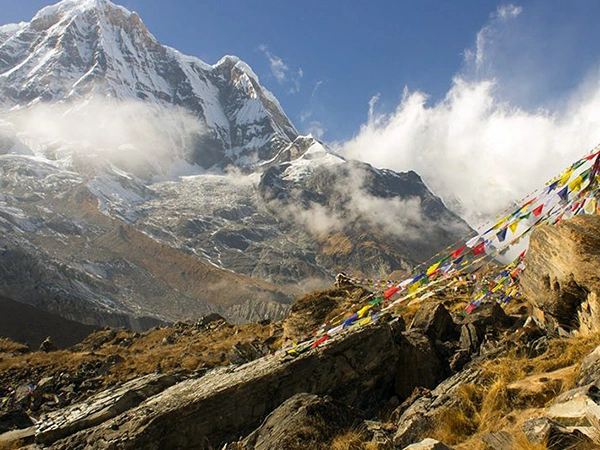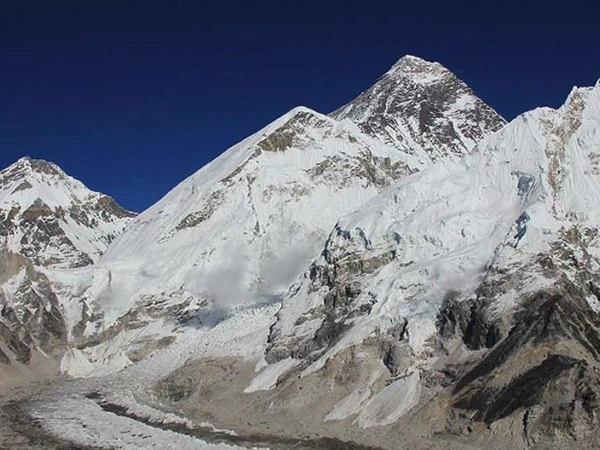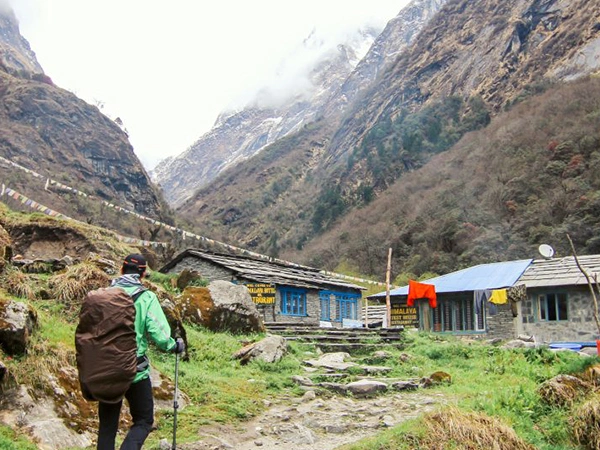Everest Base Camp Trek offers incredible views of the pristine snowy peaks and enchanting landscapes of the Khumbu Region. This magnificent adventure is the best approach to witnessing the grandeur of the Himalayas. If you are planning to go for Everest Base Camp Trek and looking for the ideal time to embark on the journey, then the autumn month of October is highly recommended.
October stands out as one of the most preferred times for trekking. During this ideal month, the days are warm, with long sunlight hours, and the air is fresh, which makes the trekking experience delightful. The crystal-clear views of the snow-capped peaks such as Mount Everest (8848.86 m), Lhotse (8516 m), Cho Oyu (8188 m), Pumori (7161 m), and many other surrounding peaks are seen. The atmosphere is tranquil in this autumn month, and you will have a pleasant trekking experience which makes the whole journey enjoyable and memorable.
The trek starts with an invigorating flight from Kathmandu to Lukla. In the clear skies of October, the flight offers breathtaking views of the lush hills, rivers, and mountains. You will have numerous chances to capture the aesthetic picture of hilly landscapes with an amazing backdrop of snow-covered mountains that look surreal, which adds an extra touch of charm to the journey.
In this article, we will learn in detail about what it is like to trek to Everest Base Camp in October.
Highlights Of Everest Base Camp Trek in October
- Exhilarating and Scenic flight from Kathmandu to Lukla.
- The beautiful and clear views of the mesmerizing and unique landscapes of the Everest Region.
- A chance to visit Tengboche Monastery.
- Trek through the protected Sagarmatha National Park.
- Mesmerizing views of the mountains like Mount Everest, Lhotse, Nuptse,
- Explore Everest Base Camp.
- Trek through the well-marked trails, witnessing charming Sherpa Villages along the trail.
- Pass through lush forests and cross the thrilling suspension bridges along the trail.
Why October Is an Ideal Time for Everest Base Camp Trek?
Enchanting Sceneries
The Everest Region is the most beautiful in the autumn month of October which is the second month of the autumn season. It is considered the most preferred month for trekking and exploration. The monsoon comes to an end by mid-September, and the skies are clear, and you can enjoy the unobstructed views of lush hills and beautiful snowy mountains. The landscapes that are rainwashed because of the rainfall in the preceding monsoon season present the clearest views of the snow-clad peaks like Everest, Lhotse, Thamserku, Cho Oyu, and many other surrounding peaks.
Interactive Journey
Trekking in the month of October allows you to have an interactive journey. As we know, autumn is the ideal time for trekking, and as it is a peak season, you will get a chance to meet with travel enthusiasts from around the world. You can communicate with fellow trekkers while sharing each other’s experiences, passion for travel and also interesting stories. You can get a chance to develop a good friendship and have an engaging journey while enjoying the spectacular views of valleys, rivers, and mountains.
Favorable Weather Conditions
During October, the weather is moderate, which creates favorable walking conditions for the trekkers. It is neither too cold nor too hot, and the air is crisp, which makes the whole journey rejuvenating. As the chance of rainfall is minimal and the weather is clear, you can witness the distinct views of snowy mountains. The trails are dry, which makes navigation easier. All these points add up, which makes October one of the best times to embark on Everest Base Camp Trek.
Festive Season
The month of October also is the time when many festivals take place. Dashain, which is the biggest festival, falls in the month of October and is celebrated by most of the people of Nepal. Similarly, Mani Rimdu, which is a 19-day festival, is celebrated in the Everest Region by Buddhists, which falls between October and November. Many shows are set up, and masked dances are performed. Trekking in October, you can get a chance to witness the festivals, which can be a truly fascinating and joyful experience.
Weather and Climate Of Everest Base Camp in October
October is one of the most favorable times for Everest Base Camp. The weather is pleasant, and the sky is clear. The clear views of the snowy peaks, such as Everest, Ama Dablam, Lhotse, and many other peaks, can be seen when you embark on the trek in the month of October. The days are warmer, while the nights and morning time are cool. The daytime temperature of Everest Base Camp ranges from around 12°C to 15°C whereas, at night time, the temperature drops upto 2°C to -5 °C.
Everest Base Camp Trek Route
The Everest Base Camp Trek starts with an exciting flight from Kathmandu to the beautiful Lukla. The flight is a perfect blend of scenic and thrilling adventure that offers ethereal views of lush hills, forests, hilly settlements, rivers, and snowy peaks. Landing at Lukla airport is one of the most invigorating parts of the trek, where you can hear the sound of applause when the aircraft lands. Lukla is the place from where you will start the trek. Passing through the suspension bridges and charming villages, you will reach Phakding and will stay overnight. In Namche Bazaar, you will have your first acclimatization day. It is the famous tourist hub, where you can find many teahouses, local markets, restaurants and cafes. You can hike to Everest View Hotel to witness the mesmerizing views of the snowy peaks on your acclimatization day.
You can also visit Tengboche monastery, which is situated at an altitude of 3867 meters, and get a chance to observe the morning prayer ceremony. The trek then takes you to Dingboche, and you will spend one more day here for acclimatization, exploring the nearby scenic places. Acclimatization days are extremely important for adapting to the change in the surroundings. So, incorporating at least 2 days is important during Everest Base Camp Trek. Namche Bazaar and Dingboche are popular places for acclimatization where you can explore the beautiful views of the awe-inspiring vistas of the Everest Region. After spending an acclimatization day in Dingboche, you will trek towards Lobuche, enjoying the incredible views of the valleys and mountains.
Trekking from Lobuche to Gorakshep and witnessing the stunning views of Pumori, Nuptse, and Everest is one of the best parts of the trek. Gorakshep is the final stop point on a trek to Everest Base Camp. Usually, trekkers stay at Gorakshep overnight and hike to Everest Base Camp in the morning of the next day. On the trail to Everest Base Camp, you can witness the enchanting views of Khumbu Glacier and Khumbu Ice Fall. You also have an option of hiking to Kala Patthar in the morning, which rewards you with the beautiful views of Everest, Nuptse, and Chagtse.
There are several itineraries we have designed for trekking in the Everest Region, and you can select one on the basis of your interest, timeframe, and goals. The 14-day Everest Base Camp Trek is one of the most fascinating trek which allows you a chance to witness beautiful vistas of the Everest Region and also explore the base camp. Similarly, if you are looking for a journey that provides the opportunity to see the wonders of the Everest Region on foot as well as get an aerial perspective, then you can choose Everest Base Camp Luxury Trek, where you will fly to Lukla from Kalapatthar via Chopper and then take the plane to Kathmandu from Lukla.
Permits Required for Everest Base Camp Trek
The permits are essential to obtain as they help the authorities keep a record of the trekkers. The revenue generated through the permit is utilized for the development of the local infrastructure and conservation of the natural environment. For Everest Base Camp trekking, you will need two permits:
- Sagarmatha National Park Permit
The cost of the Sagarmatha National Park permit is Nrs.3000 (USD 22.58), and it can be obtained from the Nepal Tourism Board Office in Kathmandu. You can also collect the permit at the entrance of Sagarmatha National Park in Monjo.
- Khumbu Pasang Lhamu Rural Municipality Permit
The cost of a Khumbu Pasang Lhamu Rural Municipality permit is Nrs.2000 (USD15. 05), and you can obtain the permit In Lukla
If you book the trip with us, we will arrange all the permits on your behalf.
What To Pack for the Everest Base Camp Trek in October
It is important to pack wisely while being aware of the different gear and equipment needed during the Everest Base Camp. As you travel through the varied terrains of the Everest Region during the trek, walking for long hours, you will need many essentials for comfort and maintaining hygiene. We suggest including the following items in our baggage.
Clothing
The weather in the high-altitude zones is mostly cold and changes rapidly, so you must pack warm clothes. During the month of October, the days are sunny, and nights and mornings are cool, so packing warm thermals and down jackets is important. Similarly, you should also include windproof jackets, comfortable trekking T-shirts, and Pants in your pack. Similarly, you must pack many undergarments and also a towel to maintain hygiene. Other must-pack clothing items include moisture-wicking shocks, warm gloves, sunhats, warm caps, and scarves. Adding Rain jackets is highly recommended because of the fluctuating weather conditions. Make sure to pack hiking boots and pair of trekking sandals, too.
Gears
Packing trekking gear like Sleeping Bags, Trekking Poles, Flash Lights, and Headlamps are necessary. Sometimes, the weather might be too cold, and blankets may not be sufficient to stay warm, so a sleeping bag is essential for warmth and comfort. The gear-like Trekking Poles, Flash Lights, and Headlamps are also important for navigation which helps for the smooth completion of the trek.
Other Important Items
Some other essentials that are required for the trek are Water Bottle (Reusable) and also water purification tablets. You can fill the water bottles in the places where you have lunch or stay. You can carry a comfortable backpack with a rain cover. Similarly, when traversing through the remote trails, you will need to have high-energy snacks and bars, so we recommend you include that, too. Other important items that are essential for trekking are sunscreen, lip balm, a small mirror, maps, portable chargers, a camera, a cell phone, a Toothbrush, Tissues, Toothpaste, Soap, Shampoo, Insect Repellent, a First Aid Kit with necessary medicines like paracetamol, painkillers, and bandages.
Meals and Accommodation
Everest Base Camp is the mainstream trekking destination and is a dream place for many adventurers. Along the trail, you will see many teahouses that serve a variety of dishes. The most common dish that is served in most of the teahouses is Dal Bhat (Rice, Lentil Soup, Veggies, and Pickles), which is liked by many as it is served warm and is also fulfilling. As you will also get a chance to explore the beautiful Namche Bazaar, you can witness that this vibrant town has many restaurants, cafes, and bakeries. Similarly, the other teahouses along the trail also serve dishes like Noodles, Pasta, Bread, Eggs, Soups, Fried Rice, Chappatis, Currys, Potato Fries, Sandwiches, Tibetan Bread, Pancakes, Porridge and many more.
As for accommodation, you will be staying in teahouses/ lodges during the trek. Most teahouses provide a cozy room with warm blankets and pillows. The bathroom can be attached in some places, where as in some places, it may be on a shared basis. The wifi and hot shower are available for which extra cost may be charged. As you move further to higher zones, the facilities can be basic, but the owners will make sure that every need of yours gets fulfilled as much as possible. The warm hospitality of the owners will warm your heart, and you will have an enjoyable and comfortable stay.
Altitude Sickness and Preventive Measures
One of the major concerns of high altitude treks is Altitude Sickness. During Everest Base Camp Trek, you will be at different elevation points, with the highest being over 5000 meters. It is important to recognize the symptoms of altitude sickness and take preventive measures. The symptoms of Altitude Sickness are:
- Headache
- Nausea and Vomiting
- Fatigue
- Having Difficulties to Sleep
- Lack of Appetite
- Rapid Heartbeat
- Blocked Ears
However, there are some preventive measures that you can follow to reduce the risk of altitude sickness.
- Trek gradually; do not rush.
- Incorporate rest days during trekking, which will help you in acclimatization.
- Maintain proper hydration.
- Consult your doctor prior to the trek if it is okay to take medications like Diamox, which are known to prevent the symptoms of altitude sickness.
- Maintain a proper, balanced diet.
- Be aware of how your body is reacting to the changing altitudes and descend to lower zones if you feel that your symptoms aren’t going away.
- In case of any uneasiness or discomfort, inform your guide immediately.
Training and Preparation for Everest Base Camp Trek
Everest Base Camp Trek’s trail passes through diverse terrains that require you to ascend and descend through many steep and narrow terrains. You need to be physically fit to complete the trek successfully. Walking through the rugged and narrow paths certainly is physically demanding and requires a good level of endurance and stamina. So, to prepare for the EBC trek, you need to stay fit throughout the journey. You can include strength training and cardiovascular exercise in your routine some weeks prior to trekking. Strength training helps you be stronger, improve your physical endurance, and improve the mobility of muscles. Some examples of strength training exercises that you can include in your routine are:
- Step Ups
- Walking Lunges
- Calf Raises
- Plank
- Deadlift
- Push-Up
- Pull- Up
Similarly, cardiovascular exercises are an important form of exercise that will help you to improve your energy levels endurance, and also increase stamina. Some types of cardiovascular exercises that you can incorporate into your routine are:
- Jogging
- Walking
- Climbing the Stairs
- Jumping Rope
- Swimming
- Cycling
- Dancing
You can also go for hiking in the local areas along with the training and exercises. Hiking is one of the best forms of practice before going to the high altitude treks. It helps to boost performance and also makes you familiar with the navigation of challenging terrains. You can develop a better understanding of traversing and also develop the stamina that is required when trekking in high-altitude areas.
Travel Insurance
Travel Insurance is important for the Everest Base Camp Trek. It requires you to allocate a significant amount of time, ranging from 9 to 14 days or even more, for the trek. So, there is also the possibility of the occurrence of certain risks. Having travel insurance will help you to be financially protected. So, It is important to have travel insurance that provides coverage against the following risks:
- Medical expenses occurred due to any accidents or illness during the journey.
- Lost or Stolen baggage during the trek.
- Emergency evacuation by helicopter in case of any unforeseen events.
- Trip disruption because of natural calamities or weather.
- Cancellation or postponement of trip.
Gain Insights On:
- Everest Base Camp Trek In September
- Everest Base Camp Trek 7 Days
- Everest Base Camp Trek 8 Days Itinerary
Tips For Everest Base Camp Trek
Research
When you are planning for any journey, doing research is crucial. When you do proper research about a trek, you will be well-informed about the challenges, cost and also about the perks you get while trekking. You can also determine if the trek is fit for you or not through the research. You can research in various ways you can check information about the trek online, watch documentaries about the trek, or contact the travel agency directly, which will help you make informed decisions.
After the research, you can plan for the trek, selecting the best time and being aware of which time is the best to embark on the journey. You can also learn about the special attractions of the trek and make special requests to include that particular place in the itinerary. So, researching is highly recommended before embarking on the journey.
Acclimatization
Incorporating rest days is very important for Everest Base Camp Trek. As you will be gaining elevation as you progress, you need to be accustomed to the changing altitude. When you can’t adapt to the changing attitudes when trekking, you may experience the symptoms of altitude sickness.
On the acclimatization day, you can do optional hikes to the nearby scenic places, which helps you get accustomed and you can complete the trek smoothly. So, incorporating the acclimatization day is highly recommended.
Hydration and Nutrition
Maintaining hydration and incorporating nutritious food is important during trekking. You will need a lot of energy and stamina throughout the trek, and for that, you need to be well-hydrated and maintain a diet including nutritious food. When you aren’t properly hydrated, then you may experience the symptoms of altitude sickness or even get sick. You will cover a long distance on rugged paths by foot, so you need to be properly hydrated and have enough stamina for a smooth journey.
Physical and Mental Endurance
Everest Base Camp Trek requires you to have a good level of physical and mental endurance. It is a known fact that trekking requires you to be fit and have a good level of stamina and strength. However, the mental endurance is equally important. Trekking through the steep sections in an unfamiliar location can certainly be psychologically challenging. In addition, some may lose the motivation to trek, seeing the narrow and rugged terrains so you need to able to cope with it having a positive mindset. You have to be confident and think about the rewards that are coming for you and have a strong mental reselience.
Communicate with Your Guide
We recommend you communicate with your guides to let them know about your needs and requirements. When you interact with your guide and inform them about your interests and preferences, it will be easier for the guide to make arrangements accordingly. When you properly communicate with your guide, you will get a chance to learn about the local culture and also understand the place better. The valuable advice of the guides will help you in navigation, and you can also have an immersive journey. Similarly, when you inform them if you feel any kind of uneasiness during any part of the journey or require medical help, they will make quick arrangements. So, communicating with the guides is important.
Be well-informed about Your Itinerary.
You should read the itinerary and must be familiar with it. When you go for the high-altitude treks, and you are informed about the routes and your itinerary, you will be walking through the designated routes only, and it will reduce the possibility of getting confused about the ways or getting lost. Similarly, knowing about the distance and duration of the trek will help you to distribute your time effectively and you will reach your destination in the pre-determined time.
Be Flexible
Being flexible is very important for trekking. Because of the fluctuating weather conditions of the high-altitude areas, there may arise a situation when you have to change the itinerary because of the weather conditions or any unforeseen events. So, it is highly advisable to be flexible in case of such situations and be ready to change the schedule accordingly.





![Best Time to Do the Tsum Valley Trek in Nepal [With Trekking Tips]](https://himalayasonfoot.com/uploads/blog/best-time-to-do-the-tsum-valley-trek-in-nepal.webp)
